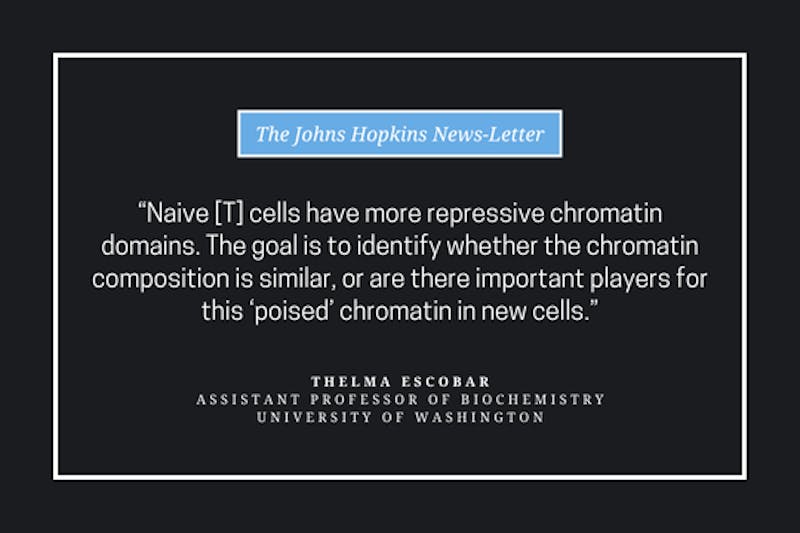Science
Thelma Escobar Unveils Findings on Epigenetics and Cancer

On September 25, 2025, Thelma Escobar, an assistant professor of biochemistry at the University of Washington, delivered a compelling presentation as part of the Hopkins Department of Biology’s Seminar Series. Her talk centered on her laboratory’s recent advancements in understanding chromatin modifications in hematopoietic stem cells (HSCs) and their implications for cancer, particularly acute myeloid leukemia (AML).
HSCs reside in bone marrow and play a critical role in maintaining blood and immune cell production. The regulation of HSC identity and differentiation is intricate, largely influenced by epigenetic factors, such as histone modifications. Inside the cell’s nucleus, DNA is negatively charged and wrapped around positively charged histones, which regulate gene expression. Regions of euchromatin, characterized by certain histone modifications, allow for increased gene expression, while heterochromatin regions remain tightly bound, restricting transcription.
During her presentation, Escobar explained, “[This process involves] a very complex orchestration of destruction [of] parental histones and recycling of histones, as well as de novo deposition, all occurring during DNA replication.” She emphasized the role of histone chaperones, proteins that guide histones to their genomic locations, in this complex process.
Escobar’s research specifically focuses on a histone chaperone protein known as Nucleophosmin 1 (NPM1), which is encoded by the NPM1 gene. This protein has a significant connection to AML, a severe blood cancer originating in the bone marrow. According to Escobar, “NPM1 mutations… [are] shown… to be present in 30 to 35% of all AMLs.” Despite this prevalence, targeted therapies for NPM1-mutated AML are currently lacking.
Escobar’s investigation aims to elucidate the role of mutated NPM1 in the development of leukemia. She posits that such mutations could lead to heightened HOX gene activity, promoting cell proliferation while impeding differentiation. This could result in HSCs overproliferating in the bone marrow, undermining their function as precursors to blood cells.
To study these processes, Escobar’s lab differentiates induced pluripotent stem cells (iPSCs) into HSCs, providing sufficient quantities for experimental analysis. One significant aspect of their research involves comparing protein interactions between normal NPM1 and its mutated counterpart. Recently, they discovered that NPM1 interacts with another protein often mutated in leukemia precursors. This finding opens new avenues for understanding the molecular mechanisms underlying AML.
Another striking result from Escobar’s research is the identification of a fragment of NPM1 located in the nuclei of HSCs, both in vitro and in vivo. This observation was unexpected, as such fragments had not been previously documented in other cell types. The lab identified a specific five-amino-acid sequence responsible for the cleavage of NPM1, which was crucial in understanding the presence of this fragment in HSC nuclei.
Escobar described the experimental approach used to pinpoint the cleavage site, noting that mutations in specific regions resulted in different fragment formations. “A mutation in the ‘incorrect’ site would produce two fragments as observed in the wild type,” she stated, indicating the complexity of protein interactions and modifications at play.
In addition to her work on NPM1, Escobar briefly discussed another research project focused on chromatin modifications in T cells, key players in the adaptive immune system. Historically, research has emphasized the rapid proliferation of B and T cells upon pathogen invasion. However, Escobar’s lab is exploring the role of chromatin states and epigenetics in this response.
She explained, “Naive [T] cells have more repressive chromatin domains,” and highlighted their goal to determine whether chromatin composition in these cells influences their activation during reinfection. Escobar theorized that immune cells with poised chromatin could respond more rapidly, as the chromatin would possess activating histone modifications that facilitate an effective adaptive immune response.
In wrapping up her presentation, Escobar expressed enthusiasm for her lab’s future projects, urging the audience to stay informed about their progress. “Stay tuned, because we’re mixing biochemistry and also hematopoietic stem cells differentiation. Hopefully, we can have this story published in the near future,” she concluded, leaving the audience eager for updates on her groundbreaking research.
-

 Politics1 week ago
Politics1 week agoDallin H. Oaks Assumes Leadership of Latter-day Saints Church
-

 Sports1 week ago
Sports1 week agoSteve Kerr Supports Jonathan Kuminga After Ejection in Preseason Game
-

 Lifestyle1 week ago
Lifestyle1 week agoDua Lipa Celebrates Passing GCSE Spanish During World Tour
-

 Business1 week ago
Business1 week agoTyler Technologies Set to Reveal Q3 2025 Earnings on October 22
-

 Entertainment1 week ago
Entertainment1 week agoZoe Saldana Advocates for James Cameron’s Avatar Documentary
-

 Science1 week ago
Science1 week agoChicago’s Viral ‘Rat Hole’ Likely Created by Squirrel, Study Reveals
-

 Lifestyle1 week ago
Lifestyle1 week agoKelsea Ballerini Launches ‘Burn the Baggage’ Candle with Ranger Station
-

 Health1 week ago
Health1 week agoRichard Feldman Urges Ban on Menthol in Cigarettes and Vapes
-

 Health1 week ago
Health1 week agoCommunity Unites for Seventh Annual Mental Health Awareness Walk
-

 World1 week ago
World1 week agoD’Angelo, Iconic R&B Singer, Dies at 51 After Cancer Battle
-

 Business1 week ago
Business1 week agoMega Millions Jackpot Reaches $600 Million Ahead of Drawings
-

 Business1 week ago
Business1 week agoMLB Qualifying Offer Jumps to $22.02 Million for 2024









